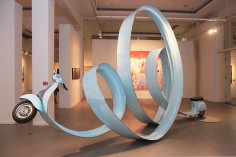EDDI PRABANDONO
After Party
source: autochunk
The creative genii across the globe usually find art in things that otherwise are discarded by us less imaginative mortals. However, when we see them in new form all we usually wonder if this could be done. One of such creative artist is Indonesia, Eddi Prabandono. This man is really endowed with an eye to find beauty in stuff like industrial waste, automobile parts, shovels and many other discarded materials and immortalizes them in his art.
Though Eddi Prabandono is renowned for creating giant sculpture of 25 tons of special clay of his daughter Luz’s head at the 2011 edition of the art exhibition Jog Art, yet he has also managed other stuff by recycling the waste thing. The most recent inclusion to his long list of art works is this multi looped Vespa which measures 640 cm × 340 cm. The material used is Iron plate and Vespa Special which is finished in duco paint.
Eddi Prabandono’s other creations also include some artwork on bicycles and other stuff that are equally impressive. While this multi-looped vespa sticks to the word ‘art for art sake’, we wonder as to what makes him think and create this multi-looped Vespa sculpture. But that’s what we really call creativity. Kudos to Eddi!
.
.
.
.
.
.
.
.
source: primaenoctis
Eddi Prabandono is an artist who involves design, planning, and construction in creating his large-scale pieces. He did not work on his pieces alone. Just like in a project, Eddi Prabandono involved many workers: to create designs and even work plans. Often, he employed construction plans that need [careful] calculation. However, his pieces did not turn into structural things, because of the way he incorporated the evolution of languages of expressions in creating them.
This way of working was born from a critical contemplation. Eddi Prabandono feels that the emergence of new media in the development of the current art world does not lead to the discovery of new languages of expression. As such, he feels as though the works which depart from conventional media of expression are [perpetually deemed as] experimental.Eddi Prabandono who tends to have little need of conventional languages of expression, feels the importance to discover a [suitable] language for his expressions.
In this search, he “hitchhiked” on the work processes that involve design, work plans, and constructions. Through work processes with a clear modus operandi, he [finally] discovered a working language with a clear grammar. Eddi Prabandono built his language of expression through this working language. That is, he is not always subservient to the rules of this working language. He provokes the language, searching for problems, looking for its answers to solve them.


